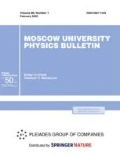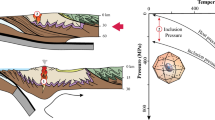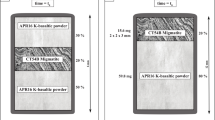Abstract
To optimize heating conditions during the Thellier procedure and to improve the reliability of paleofield determination, thermal stability experiments with titanomagnetite and titanomaghemite obtained by laboratory heating were conducted. The experiments were performed on P72/2 and P72/4 basalts of the rift zone of the Red Sea that contain titanomagnetite with a concentration of the magnetite component equal to (44.7 ± 3.9)% and (46 ± 5)%, respectively. It has been shown that the single-phase oxidation process prevails in annealing of titanomagnetite for 10 hours in a temperature range of 290–410°C in air. An increase in the annealing temperature up to 460–535°C means that single-phase oxidation is replaced by oxi-exsolution. The temperature range of thermal stability of the single-phase oxidized titanomagnetite expands with the degree of oxidation. In particular, at an oxidation state close to 0.9, titanomaghemite is stable up to temperatures of 410–460°C.
The use of the Thellier technique for studying the properties of the chemical remanent magnetization of single-phase oxidized titanomagnetite with an oxidation state above z ≥ 0.6 is limited to approximately 20% of its value. It is possible to stabilize the single-phase oxidized state of titanomagnetite at temperatures above 460°C and thereby to improve the quality of CRM research using the Thellier method by adjusting the value of the oxygen partial pressure.
Similar content being viewed by others
References
A. N. Khramov, G. I. Goncharov, R. A. Komissarova, et al., Paleomagnetology (Nedra, Leningrad, 1982).
P. W. Readman and W. O’Reilly, J. Geomagn. Geoelectr. 24, 69 (1972).
U. Bleil and N. Petersen, Nature 301, 384 (1983).
U. Draeger, M. Prévot, T. Poidras, and J. Riisager, Geophys. J. Int. 166, 12 (2006).
R. S. Coe, J. Geomagn. Geoelectr. 19, 157 (1967).
V. I. Maksimochkin and A. N. Tselebrovskiy, Moscow Univ. Phys. Bull. 70, 566 (2015). https://doi.org/10.3103/S0027134915060132
S. K. Gribov, A. V. Dolotov, and V. P. Shcherbakov, Izv., Phys. Solid Earth 53, 274 (2017).
S. K. Gribov, V. P. Shcherbakov, and N. A. Aphinogenova, in Recent Advances in Rock Magnetism, Environmental Magnetism and Paleomagnetism, Ed. by D. Nurgaliev, V. Shcherbakov, A. Kosterov, and S. Spassov (Springer, 2018), p. 173.
P. A. Selkin and L. Tauxe, Philos. Trans. R. Soc. London, A 358, 1065 (2000).
G. V. Zhidkov, V. P. Shcherbakov, A. V. Dolotov, M. A. Smirnov, A. A. Ovsyannikov, and P. Yu. Plechov, Izv., Phys. Solid Earth 53, 162 (2017).
E. Herrero-Bervera and J.-P. Valet, Earth Planet. Sci. Lett. 287, 420 (2009).
N. R. Khisina, Subsolidus Transformations of Solid Solutions of Rock-Forming Minerals (Nauka, Moscow, 1987).
A. Putnis and J. D. C. McConnell, Principles of Mineral Behavior (Blackwell, 1980).
A. A. Shreider, Geomagnetic Research in the Indian Ocean (Nauka, Moscow, 2001).
Underwater Geological Exploration with Manned Submersibles, Ed. by A. S. Monin and A. P. Lisitsyn (Nauka, Moscow, 1985).
V. I. Maksimochkin, V. I. Trukhin, N. M. Garifullin, and N. A. Khasanov, Instrum. Exp. Tech. 46, 702 (2003).
J. C. W. Richards, J. B. O’Donovan, Z. Hauptman, W. O’Reilly, and K. M. Creer, Phys. Earth Planet. Inter. 7, 437 (1973).
R. Day, M. Fuller, and V. A. Schmidt, Phys. Earth Planet. Inter. 13, 260 (1977).
S. K. Gribov, Candidate’s Dissertation in Mathematics and Physics (Institute of Physics of the Earth, Russ. Acad. Sci., Moscow, 2004).
T. Nishitani and M. Kono, J. Geophys. 50, 137 (1982).
Acknowledgments
The authors thanks A.N. Nekrasov (Institute of Experimental Mineralogy of the Russian Academy of Sciences, Chernogolovka) for his help in performing the microsonde tests.
Funding
This work was partially supported by the Russian Foundation for Basic Research (project no. 16-05-00144).
Author information
Authors and Affiliations
Corresponding author
Additional information
Russian Text © The Author(s), 2019, published in Vestnik Moskovskogo Universiteta, Seriya 3: Fizika, Astronomiya, 2019, No. 6, pp. 113–120.
About this article
Cite this article
Maksimochkin, V.I., Grachev, R.A. The Stability of Titanomagnetite Basalt of the Red Sea during Heating in Air and Argon. Moscow Univ. Phys. 74, 697–705 (2019). https://doi.org/10.3103/S0027134919060195
Received:
Revised:
Accepted:
Published:
Issue Date:
DOI: https://doi.org/10.3103/S0027134919060195




